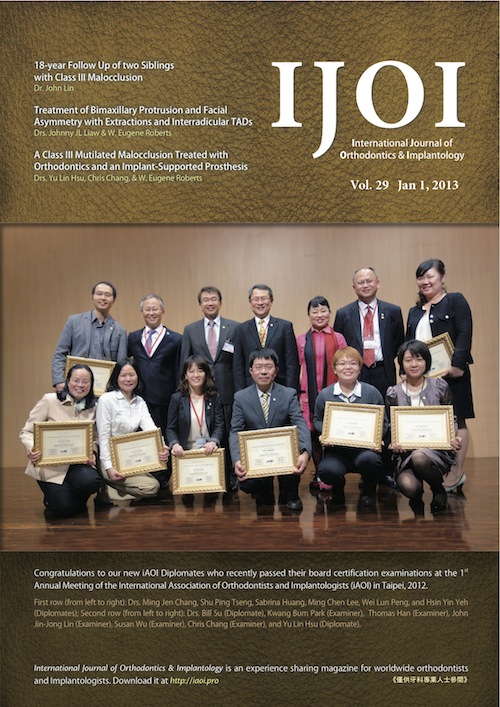IJOI Vol. 29

18-year Follow Up of two Siblings with Class III Malocclusion
Lin JJ
Introduction
Treatment of skeletal Class III malocclusion with conventional orthodontic appliances usually requires orthognathic surgery. If patients have an acceptable profile, temporary anchorage devices (TADs)1 and passive self ligating brackets, including the Damon system,1 are viable alternatives for some Class III malocclusions. (Int J Orthod Implantol 2013;29:4-19)
Treatment of Bimaxillary Protrusion and Facial Asymmetry with Extractions and Interradicular TADs
Liaw JL, Roberts WE
History and Etiology
A 21 year old male, with a family history of Class III malocclusion, sought consultation for protrusion and imbalance of the lower face. Despite an apparent Class III skeletal pattern (Table 1), clinical examination revealed a Class I dental relationship, complicated by anterior openbite tendency, midline deviation, facial asymmetry, and bimaxillary protrusion (Figs.1-3). Note that the right buccal segment appears to be Class III due to the angulation of the photograph (Fig. 2), but the direct buccal view of the articulated casts (Fig. 3) shows that the relationship is actually Class I. This discrepancy demonstrates that casts are more reliable than intraoral photographs for diagnosis of intermaxillary occlusion in the sagittal plane. (Int J Orthod Implantol 2013;29:24-35)
A Class III Mutilated Malocclusion Treated with Orthodontics and an Implant-Supported Prosthesis
Hsu YL, Chang CH, Roberts WE
History and Etiology
A 24 year old female was referred by her dentist for orthodontic consultation (Fig. 1). Her chief concern was difficulty in incising food and chewing with her posterior missing teeth (Figs. 2-3). There was no contributory medical history, but she had an extensive dental treatment history involving extractions, endodontics and multiple restorative procedures. To restore optimal occlusal function, an interdisciplinary treatment plan was proposed that included orthodontics, implant site preparation, an implant-supported prosthesis, and new crowns on the maxillary incisors. The patient was treated to an optimal result as documented in Figs. 4-9. The details of diagnosis and treatment will be discussed below. (Int J Orthod Implantol 2013;29:36-57)
Nonsurgical Treatment of a Class III Patient with Bilateral Open Bite Malocclusion
Hsieh CL, Chang CH, Roberts WE
History and Etiology
A 25-year-9-month-old young lady, with an unremarkable medical history, presented for orthodontic consultation (Figs. 1-3). Her chief concerns were “my underbite and my side teeth don’t touch.” Clinical examination indicated Class III dental malocclusion, an end-to-end incisal relationship, bilateral posterior open bite, dental crowding in both arches, poor lip balance, and a slightly concave facial profile. There was a slight chin deviation to the right, but facial asymmetry was within normal limits. (Int J Orthod Implantol 2013;29:62-75)
A treatment of a bimaxillary protrusion case with canine substitution and impacted third molar uprighting
Yeh HY, Chang CH, Roberts WE
History and Etiology
This female adult, aged 34 years 5 months, came for orthodontic evaluation. Her chief concern was dissatisfaction with her smile (Fig. 1). There was no contributory medical or dental history. Clinical exam revealed an upper left lateral incisor missing and anomalous morphology of the upper right lateral incisor. Her lower first molar had deep caries with defective crown (Figs. 2-3). After 44 months of orthodontic treatment, the patient was treated to an acceptable result as documented in Figs. 4-9. The details for diagnosis and treatment will be discussed below. (Int J Orthod Implantol 2013;29:76-88)